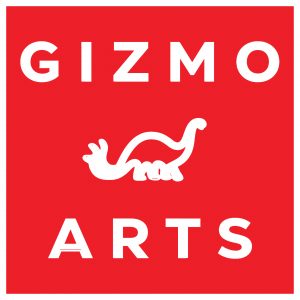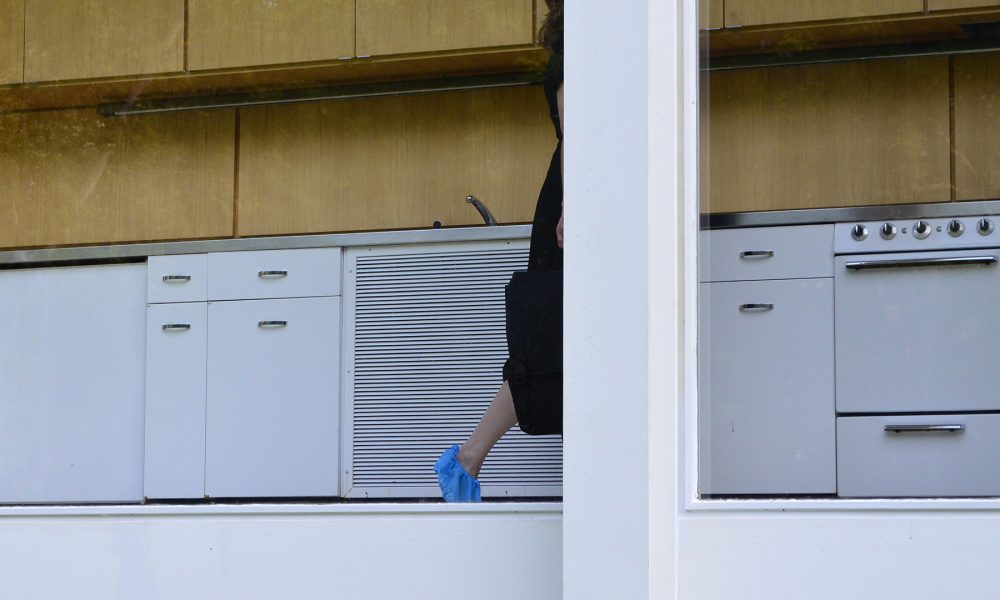
Beautiful Test Sites / Now I am become death
Beautiful Test Sites / Now I am become death
July 13 – August 31, 2018
Opening Reception: Friday, July 13, 2018, 6 – 9 pm
In Beautiful Test Sites / Now I am become death, Mitchell Squire and Nora Wendl make full use of their research-based and architecturally-founded practices to present a series of photographs that meditate upon “beautiful test sites”: spaces and bodies wastelanded by the American techno-utopian imagination of the 20th century. For Squire, this means unearthing a series of inherited mid-20th century photographs taken by an amateur photographer—who at the time served as Executive Secretary of the Iowa Industrial and Defense Commission (1941-45), the first Director of the Iowa Development Commission (1945-53), and State Director of Civil Defense during WWII and again in the 1950s—and whose subjects were both women and nuclear blasts, whose images Squire alters through the strategic use of gilded frames, veils, and glass vases. Nora Wendl presents a series of photographs taken during her recent occupational performance of the all-glass Farnsworth House, designed by Mies van der Rohe for Dr. Edith Farnsworth in the mid-20th century—a house that was conceived the same year as the first American nuclear test. Wendl pairs these with a series of archival photographs of women within this house who have commonly been mistaken as being Dr. Farnsworth, which she heavily annotates with autobiographical and biographical information, thus bringing specificity to women who are otherwise anonymous within the visual discourse of architectural history: researcher and subject alike.
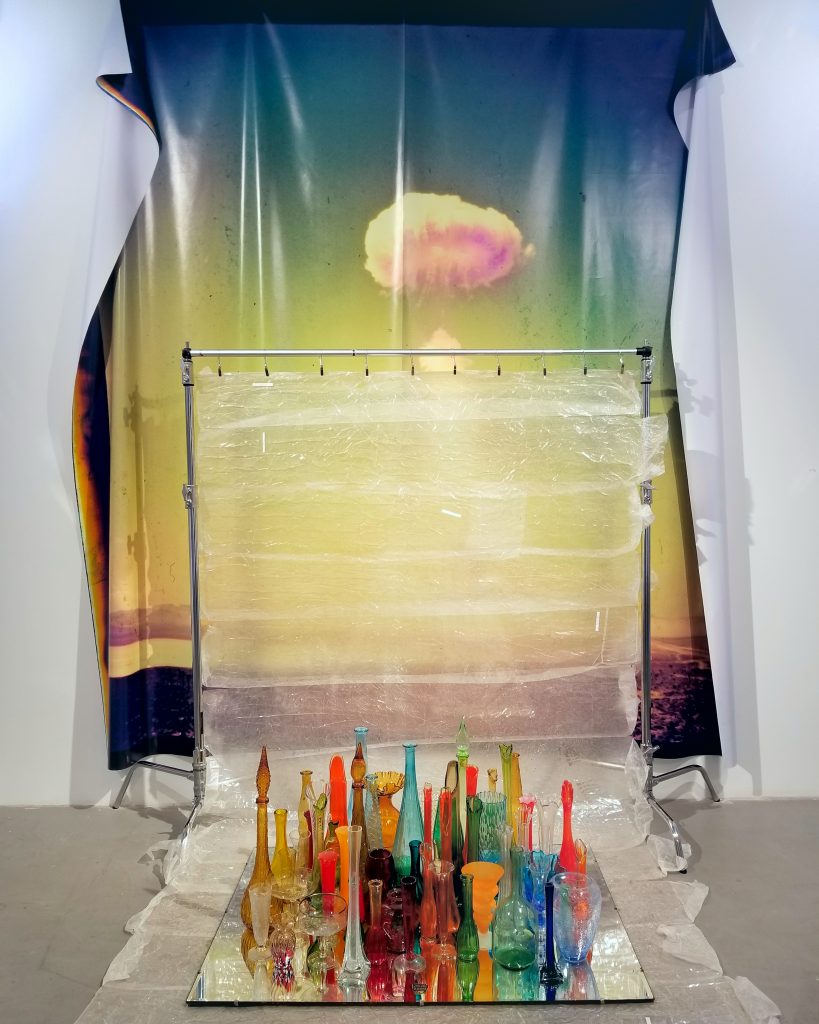
Above Image: Mitchell Squire, all your fears are caused from novel reading, 2018
The mode of operation in viewing visual information today, and particularly photographs, is that even a casual observer must work as a journalist to determine veracity. At the same time, the photograph is a way to arrest beauty, to prolong it, and to catalog even those places and bodies that are wastelanded until a future time when they can be read and named.
Mitchell Squire: Mitchell Squire is an artist and educator whose practice encompasses architecture, visual art, and the study of material culture. His work employs techniques of assemblage and informational strategies of collection and archival presentation, toward understanding the sociopolitical complexity of material and immaterial artifacts. He holds the position of Professor of Architecture at Iowa State University.
Nora Wendl: Nora Wendl is a writer, artist and educator who uses disciplinary strategies drawn equally from literature, visual art, and architecture to amplify overlooked or suppressed narratives within the built and unbuilt environment. She holds the position of Associate Professor of Architecture at the University of New Mexico.
Gently Radical Changing
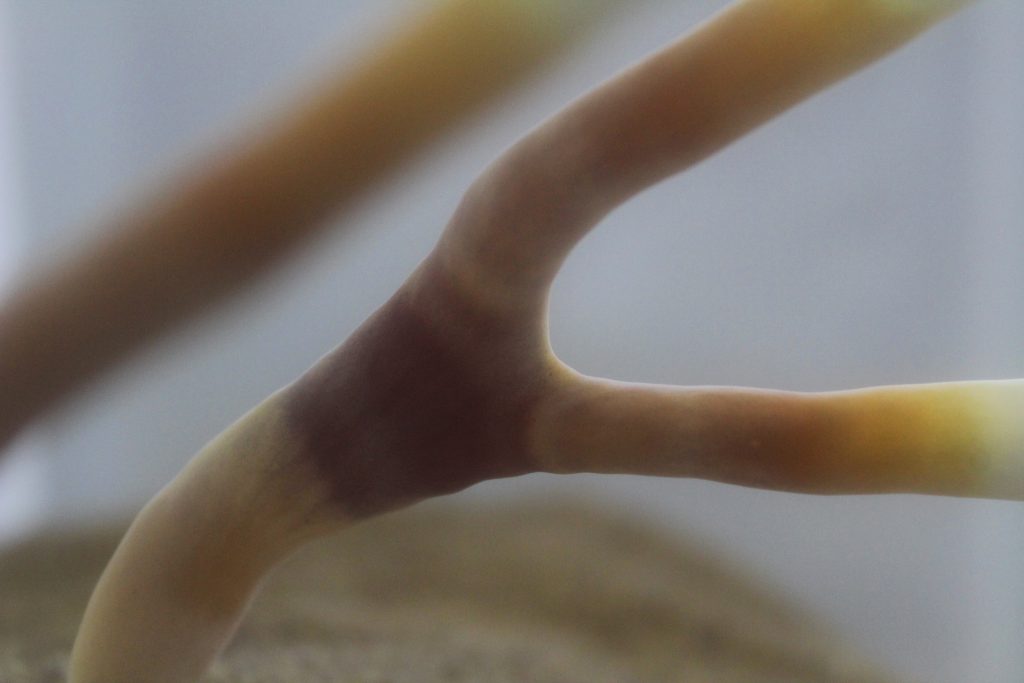
Joining in Acknowledgement (detail), Reishi mushroom, weaving, 13″ x 6″ x 15″
April 27 – May 11, 2018
OPENING RECEPTION: Friday, April 27 6-9pm
Poetry reading by Beata Tsosie-Peña 7:00pm
CLOSING RECEPTION: May 11, 2018 – 6:00-9:00pm
In Gently Radical Changing, Kaitlin Bryson engages with the legacy of toxic contamination and subsequent trauma in ecologies ridden with histories of environmental injustices. The work presented in the exhibition offers gestures of remediation and healing to these places, through bioremediative sculpture and performance, video, installation, and participatory workshops. In partnership with the Environmental Justice department of Tewa Women’s United, based out of Española, New Mexico, this work synergistically explores how radical environmental and social change can happen through compassionate acts of interspecies collaboration.
The work presented in the exhibition will transform and physically change throughout the duration of the show. Some works will appear and others will disappear. Viewers are encouraged to stop by throughout the exhibition run to observe the living works.
Exceptional Visual Artist Scholar Series
Gently Radical Changing, new works by Kaitlin Bryson is one of two exhibitions in 2018 that is part of Sanitary Tortilla Factory’s Exceptional Visual Artist Scholar Series. The Exceptional Visual Artist Scholar Series offers professional space for the culminating exhibition that defines the student’s launch into their profession as an artist. The series hopes to underscore exceptional artists attending regional institutions while highlighting Albuquerque’s historic connection to contemporary art practice.
About the Artist
Kaitlin Bryson lives and works in the high deserts of New Mexico, and has spent her life working as an artist and organic farmer. Drawing from her experience as a cultivator, her artwork illuminates the processual nature of life through the lens of transformation. Biological materials are embedded into her work so that the “finished” pieces have the potential to play, transform, and live out their own dynamic processes. Her work unfolds as restorative gestures for human and nonhuman audiences, serving as a reminder that mutability and adaptability are the common grounds we all inhabit.
Bryson received a Bachelor of Fine Arts from The University of Nevada, Reno in 2012, and is pursuing a Master of Fine Arts in Art & Ecology from the University of New Mexico. Her work has been included in group exhibitions at The Holland Project in Reno, Nevada, Site Santa Fe, and BioCultura in Santa Fe, New Mexico, and has been performed at The Holocene in Portland, Oregon. In January of 2018 Bryson will participate in the Interface Residency Programme in Gallway, Ireland, supported by funding in part from the Andrew W. Mellon Foundation, and the Lannan Foundation.
Football
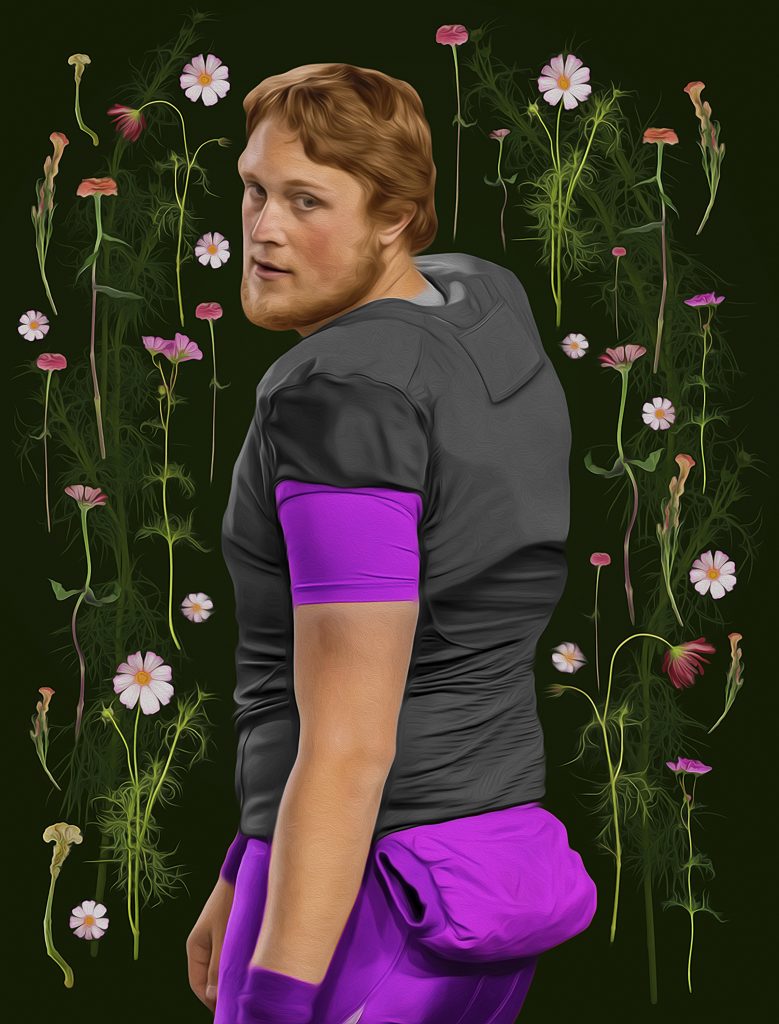
Nick Simko, Football (1), 2018
April 6 – 21, 2018
OPENING RECEPTION: Friday, April 6, 6-9pm
Artist Talk: Monday, April 9, 4-5 PM, UNM College of Fine Arts, Room 1020
Football is a manifestation of the cultural processes that shape male-identified formations of body. Using a visual vocabulary that hovers between photography and painting, these works on paper explore the aspects of heroism, romance, and idealized gender role play embedded in representations of college football players.
Exceptional Visual Artist Scholar Series
Football is Nick Simko’s UNM MFA Photo thesis exhibition and the first of two exhibitions in 2018 that is part of Sanitary Tortilla Factory’s Exceptional Visual Artist Scholar Series. The Exceptional Visual Artist Scholar Series offers professional space for the culminating exhibition that defines the student’s launch into their profession as an artist. The series hopes to underscore exceptional artists attending regional institutions while highlighting Albuquerque’s historic connection to contemporary art practice.
About the Artist
Nick Simko is an interdisciplinary artist. Simko’s work has been exhibited at museums and galleries throughout the United States including the Walters Art Museum, The University of New Mexico Art Museum, 516 Arts, and Hillyer Arts Space. Simko holds a BFA degree in Art History, Theory & Criticism from the Maryland Institute College of Art and is presently completing an MFA in Photography at the University of New Mexico.
Migrations
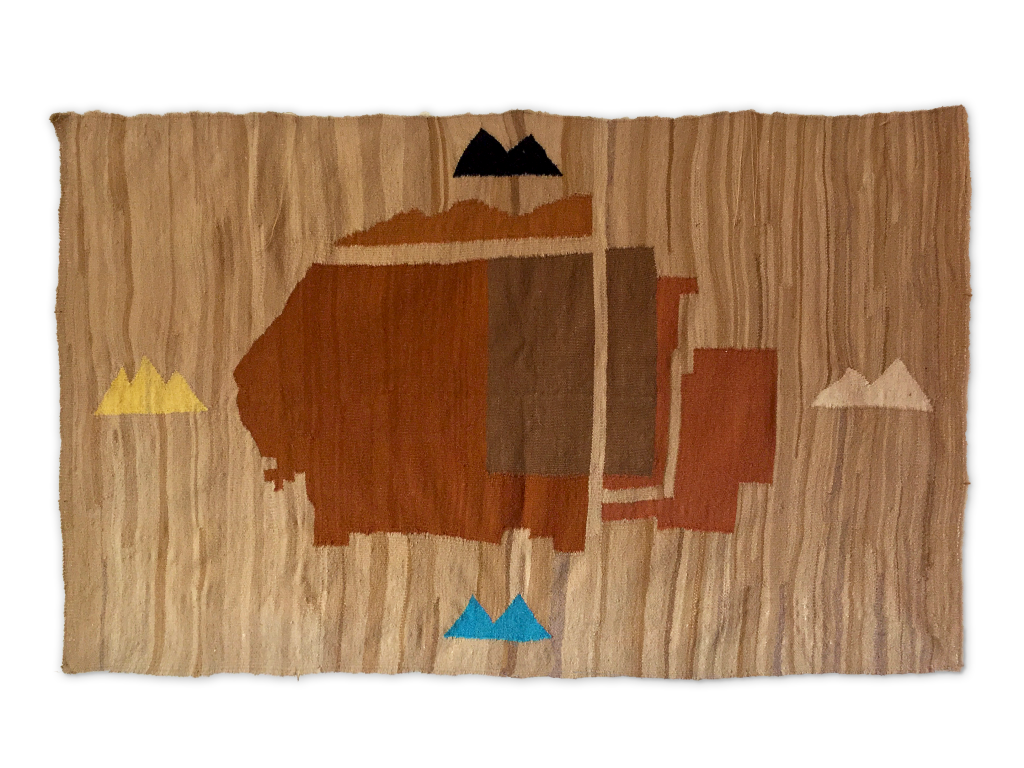
neiiKAI [we walk around…], Dinétah diyogíj, Eric-Paul Rienge, 62”x38”, 2017
MIGRATIONS
curated by Candy Nartonis and Ellen Babcock
March 2 – March 30 , 2018
OPENING RECEPTION: Friday, March 2, 6-9pm
Migrations contextualizes human migration so that it can be mourned, accepted, embraced, and even in some circumstances celebrated. In our present world, millions of people have been forced to leave their homes. Political danger, famine, earthquakes, fire, rising water, and personal tragedy have caused so many human beings, world-wide, to experience displacement. Forced migration and movement made by choice are two sides of this range of journeys motivated by survival and by dreams of a better life. Important to this story are the migrations to find better and more suitable work and to reconnect with family.
Albuquerque as a city and Alburqueños as a people recognize the richness that migrations have brought to our state. As a group we have been particularly sensitive to the problems our new neighbors encounter. We reached out to many concerned groups while we planned this exhibition and the related events. They have all helped tell this story of current and historic migration.
Migrations touches on the sanctuary movement, the difficulty of crossing national borders, and threats of deportation. It will include community members who migrated or have family stories to tell. We’ll include supporting materials such as maps and histories. A room representing a safe place will fill the center of the gallery space. Inside this space, you will hear personal accounts of forced exodus, uprooted families, war and political and natural events that compel people to move. You will be able to add your own story or consider what you would do if you found yourself in this situation.
Artists and scholars contributing to the exhibition:
Ellen Babcock, Adam Herrera, Evey Jones, Israel F. Haros Lopez, Troy Lovato, David Mora, Candy Nartonis, Zeke Peña, Reed Perkins, Eric-Paul Riege, Jim Roeber, Carol Weber
Related Events:
Sunday, March 4: New Mexicans in Movement: off-site
First of the series: Sunday, March 4, 10am-12pm
We are sponsoring a series of guided walks to interact, share and connect with New Mexican global wanderers; persons for whom migration has defined their lives and the personality of our state. Among the hosts are successful innovators, former diplomats, misfits, multi-generational New Mexicans, as well as recent arrivals. These walks are created by Sidni Lamb at Mindful New Mexico. Check Mindful New Mexico website
http://www.mindfulnewmexico.com/ for dates, locations, and descriptions of walks in the series.
Saturday, March 10: 7pm, The Sanitary Tortilla Factory
Israel F. Haros Lopez performs Mexican Jazz
Poems of migration from his recent publication of Mexican Jazz, a graphic codex novel about women and children in detention centers. He will also be reading excerpts form his latest works, La Llorona Xronciles and Ghostbraids. La llorona Xronicles retells the classic story of La Llorona, the weeping woman and interrupts narratives of myths and oral histories. Ghostbraids is an exploration of Chicano poetry, experimenting with bilingualism, immigration and diverse poetic forms, visual poetry, improvisation and soundscapes, each reading of these works become site specific.
Saturday, March 24, 5-7pm, The Sanitary Tortilla Factory
Potluck Dinner and Music: you are all invited to this celebration of gifts. Bring a food offering from your homeland, write your family history, meet others.
We’ll supply plates and forks, drinks, and food from around the world.
Interior Landscapes
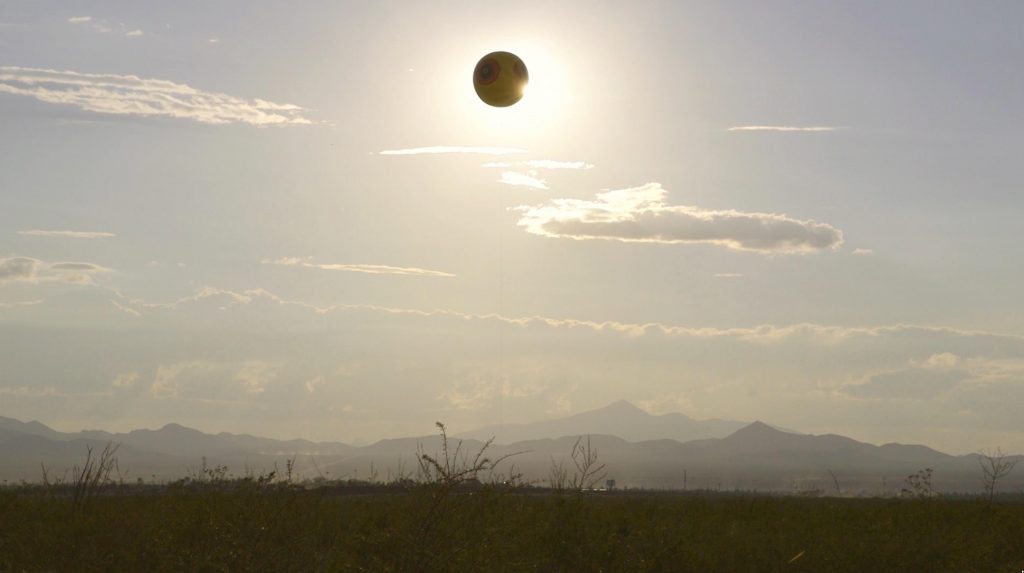
31°19’19.10”N; 109°29’47.62”W: And Golden Light, 2017, video still, courtesy of Bockley Gallery
POSTCOMMODITY ERIC PAUL-RIEGE
M. JENEA SANCHEZ TARA EVONNE TRUDELL
INTERIOR LANDSCAPES
JANUARY 26 – FEBRUARY 23, 2018
OPENING RECEPTION: Friday, January 26th 6-9pm
Performances: Opening night 7pm and February 23rd 7pm
Interior Landscapes is an exhibition presented by Sanitary Tortilla Factory and 516 ARTS as part of a collaboration for “The US-Mexico Border: Place, Imagination, and Possibility”. Interior Landscapes co-curated by Daryl Lucero and sheri crider. The exhibition focus is on the lived experience of people on the U.S.-Mexico border. Elemental to these stories are the absence of political demarcations. Where the border suggests a bifurcation of territoriality, there also exists the space between the north and south.
The artists in this exhibit find themselves living in varying proximities with the border—Arizona, New Mexico, and Sonora. Although the artists vary in social, cultural, and geographical distances, the work engages communities situated on the border. The works are collaborative and signify the reciprocal nature in which borders can be negotiated, and recreated to benefit those within them.
The works are examples of socially engaged art that humanize the border wall and its symbol of national identity, culture, and politics. And what we see are the acts that speak to living in a place of tension, violence, and creativity. The border becomes possessed by the humanity of those within it. What we witness are the stories, experiences, and truths not of the artists, but through the medium of conversation between the artists and communities. We witness the creativity of people and place.
In Border Tapestry (2009) M. Jenea Sanchez teases the absence of the border wall by transforming its purpose to divide and uses it to unite. Sanchez utilizes the steel structure as a loom to weave, to recall and connect to the “familial roots of the border communities, the families that are separated by the fence, and the days when movement across was more fluid and natural rather than militarized.”
Tara Evonne Trudell’s work physically transforms the words and messages of those living within the border area. Tara Evonne Trudell hosts poetry workshops with communities situated on the border. In these workshops, participants create poems that are then created into beads which become long strands of poetry. Tara Evonne Trudell see this work as a way to “address the realities of trying to cross the border: a trip plagued with dangerous environments and a heavily militarized zone.”
From the outside looking in, the border can be flat and two-dimensional. These works bring to light the life within. The border is animated, mocked, teased, and made human.
Click here to read the exhibition brochure
Thank you to 516 ARTS for making this exhibition possible.
516 ARTS US-Mexico Boarder Program Guide

